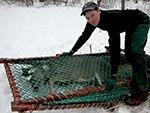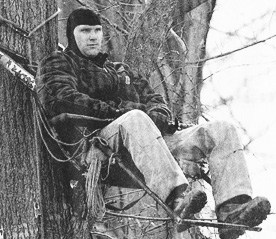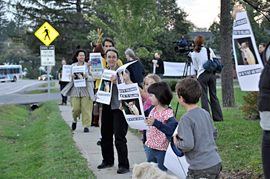|
Petition: Tell Cornell to Stop Trapping Deer and Shooting Metal Rods Into Their Brains
 Read and sign the petition here Read and sign the petition here
* * * * * * * BREAKING * * * * * * *
CayugaDeer.org has confirmed that Cornell is now using
the barbaric trap & bolt method to kill deer in the Ithaca community. Read our Breaking Story
CNY Central reports | WBNG-TV reports | The Ithacan reports
* * * * * * * * * * * * * * * * * * * * * * * * * * * * * * * * *
|
| |
|
|
|
|
|
| |
Call Mayor Kate Supron (607) 257-1238
Tell Mayor Supron and the Cayuga Heights Trustees to abandon their unsafe, reckless, ill-conceived plan to bait and shoot deer in village backyards. We can address conflicts with deer in ways that won't put the community at risk and won't turn neighbor against neighbor.
Check out the safe, proven,inexpensive and effective alternatives to killing
|
|
|
|
| |

Cayuga Heights passes new law permitting shooting in resident backyards
In 2012, despite an outpouring of protest, the Village trustees passed Local Law J, making it legal for deer-killing contractor White Buffalo (employee pictured above) to perform mass-shooting of wildlife in family neighborhoods. Now, there is only one thing that can stand in the way of the Cayuga Heights government bringing gunmen into the community to discharge deadly weapons at undisclosed locations and times: The refusal of individual property owners to allow the killing of deer on their land or near their homes.
• What you can do • |
|
|
|
Cayuga Heights has been said to have the most Ph.D’s per capita of any municipality in America. Yet today, its trustees are on the verge of approving an expensive, dangerous, and frankly bizarre plan that if put into effect, is certain to put a serious dent in our community’s well-deserved reputation for sensible, compassionate, and forward-thinking public policy.
As most people in Ithaca know, there has been a controversy around the fate of the deer in Cayuga Heights, whose appetite for tulips, heirloom tomatoes, and ornamental shrubbery has, in the minds of the current mayor and trustees, created a situation so dire and unacceptable, that action of the most extreme sort is not only justified, but urgently required.
According to the plan now being considered, every single deer in the village is slated to be violated or killed. The first phase involves capturing 20-60 female deer, surgically sterilizing them, then puncturing their ears with numbered tags and encumbering their necks with radio collars. These are the “lucky” individuals. The intended fate of every other deer in Cayuga Heights, including pregnant does and fawns, is to be shot dead at 8 to 10 undisclosed bait sites in our neighborhood backyards. This annual massacre, to become a part of our local culture, will be carried out by out-of-town contractors who earn their living exterminating wildlife.
The ethical grotesquery of this plan appears to be lost on those who conceived it, who seem to be oblivious to the mental and emotional torture that will be experienced by the few deer chosen to survive, not to mention the many people who care about these gentle animals. Year after year, deer in and around Cayuga Heights will be lured by piles of corn into the kill zone, and those marked for survival will watch as their herd mates are brutally killed right in front of them. Were such a sadistic policy to be carried out against dogs or cats, or horses, an outraged crowd of us would spontaneously rise up to stop it. But the deer, ironically, because they live free of direct human control and are no individual’s private property, are somehow seen as unworthy of moral consideration.
Do we really want to live in a society where bureaucrats meet behind closed doors to arbitrarily decide how many of each species are allowed to live, then send technicians out to mark the few chosen to survive as ornamental reminders of a bygone era, doomed to move among us as freaks festooned with the trappings of their utter domination by humans? Do we want to cover the eyes and ears of our children as unsuspecting animals are methodically executed in our neighbors’ backyards?
Living amongst us are many people who, through wise plant choices, and skillful use of fencing and deer repellents, enjoy beautiful gardens without causing harm to anyone. Mass killing and extreme control of our indigenous wildlife is neither necessary, nor ethical, nor safe. And if it is scientific at all, it represents science at its most twisted.
Everything about this plan is emblematic of the mindset that is destroying our planet, and at odds with what we stand for as a community. Because the trustees of Cayuga Heights have rejected proven and practical non-violent approaches to reducing deer-human conflict, because they refuse against all reason to allow residents to erect fences high enough to safeguard their plantings, should the rest of us just sit back and do nothing? Should we accept armed men firing deadly weapons in our neighborhoods, to protect tulips? Or is it possible, with all the brilliant, creative and compassionate people living in this community, that we can come up with a more sensible approach? I think we can.
by James LaVeck an award-winning documentary filmmaker and a 20-year resident of Ithaca, NY. He is one of the co-founders of CayugaDeer.org, Ithacans for Safe, Rational and Ethical Solutions to Deer Human Conflict. This opinion piece was originally published in the Ithaca Times on June 24, 2009
|
|

|
Understand why bringing snipers into our neighborhoods to kill deer is unsafe, unethical, unrealistic and unnecessary.
Since the Fall of 2008, a group of citizens residing in Cayuga Heights and surrounding neighborhoods has been attending meetings, reviewing scientific research, evaluating the validity of claims being made by those who advocate a deer-killing program, and investigating what’s happening in other communities facing this issue. We have also sought to understand the true sources of deer-human conflicts and how they might most effectively be reduced.
In all our study, one clear truth has emerged: Our community will be divided by any solution that doesn’t respect both the needs of gardeners and the values of people opposed to a deer killing program.
Safer roadways are good. Vibrant gardens are good. Respecting and protecting animals is good. Treating these things as mutually exclusive will only result in pitting well-meaning people against one another. Our community can do better.
Some gardeners now feel their interests will have been abandoned if a deer killing plan is not implemented. Meanwhile, those who care about the fate of the deer, and those opposed to bringing guns and violence into our community, will feel violated by an annual bait-and-shoot program.
The right approach for our community should not leave some residents feeling ignored, and others violated. It should provide direct assistance to those experiencing the greatest conflict with deer, while preserving the peaceful, non-violent culture our community is known for. The right approach should be pragmatic, ethical and economically sustainable. It should bring people together, not tear neighborhoods apart.
Learn more

|
|
|
|
|
| |
A positive resolution of this issue depends on individual people getting involved and taking action.
1. Contribute to the Deer Legal Fund
Several times in the last few years, legal intervention has prevented the mass slaughter of deer in our community. It has also served to rein in abuses of power by Cayuga Heights officials, who have exhibited a consistent pattern of suppressing information and frustrating citizen participation in the public policy debate. Your contributions will help us continue this important work, which not only makes a difference locally but also inspires and informs legal initiatives to prevent mass slaughter of wildlife in other communities.
Checks should be made out to " Deer Legal Fund" and mailed to Deer Legal Fund, c/o CayugaDeer.org, PO Box 373, Ithaca, NY 14851. Thank you for your crucial support!
2. Contact the Decisionmakers
Tell them why you think their deer-killing plan is unsafe, unethical, unrealistic, and unnecessary. Each of the individuals below can be reached by US mail at 836 Hanshaw Rd., Ithaca, NY 14850 and by phone at (607) 257-1238. You do not have to be a Cayuga Heights resident to let your voice be heard. This decision affects the entire Ithaca community and sets a dangerous precedent for other communities around North America!
| To send an email to all of the decisionmakers at once, click here. |
3. Attend Meetings
The Cayuga Heights Board of Trustees meets the second Monday of every month. Their meetings are open to the public, and time is set aside during each meeting for the public to give comments. Residents from the Ithaca area are encouraged to attend and speak out against the proposed bait-and-shoot deer-killing plan, which will bring snipers and violence into our peaceful community.
 Next monthly meeting of the Cayuga Heights Board of Trustees Next monthly meeting of the Cayuga Heights Board of Trustees
• Monday, April 14 at 7 PM
Privilege of the Floor normally happens during the first half hour of the meeting. A two-minute time limit on comments is strictly enforced.
Marcham Hall, 836 Hanshaw Rd., Ithaca Map/Directions
|
4. Write Letters to the Editor
• The Ithaca Journal
Send to: Editor, Ithaca Journal, 123 W. State St, Ithaca, NY 14850 or submit by email
• Tompkins Weekly
Send to: Editor, Tompkins Weekly, PO Box 6404, Ithaca, NY 14851 or submit by email
• The Ithaca Times
Send to: Editor, Ithaca Times,109 N. Cayuga St., Ithaca, NY 14850 or submit by email
|
5. Sign up below for email alerts and join us on Facebook and Twitter
6. Help educate others
Get your friends, neighbors and colleagues involved in the public dialogue about this important issue. Begin by letting them know about this web resource. Just click on the button below:
This web site is published by CayugaDeer.org - Ithacans for Safe, Ethical, and Rational Approaches to Reducing Deer-Human Conflict. We are a group of concerned citizens from Ithaca neighborhoods, including Cayuga Heights. If you would like to join our educational outreach effort and be informed of opportunities where your input can make a difference, contact us.
|
|
|
|
